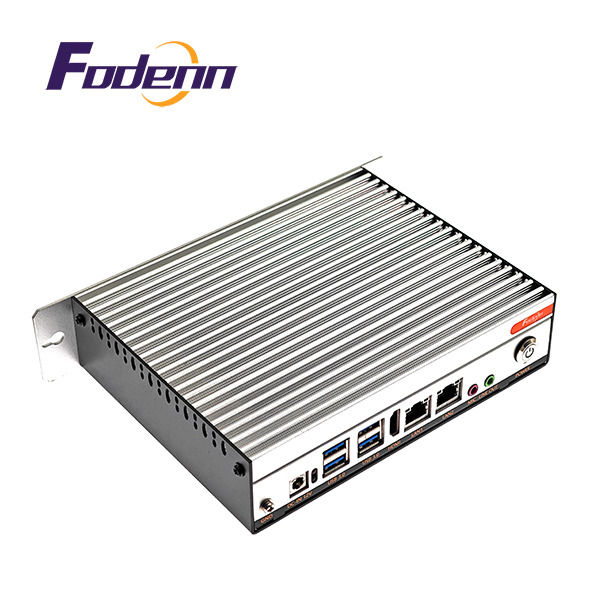Why is Passive Cooling System Crucial for PC Heat Management?
Jan 03, 2025
In the realm of industrial computing, the demand for reliable and robust systems that can operate in harsh environments is ever-increasing. Whether it's in the form of automated picking arms in automotive plants, self-driven mining machines, or automated drilling, intelligent manufacturing and railway operations, these compact robust industrial pc systems offer the dependability and performance that industries require.
This demand has led to the development of fanless embedded industrial computers, which offer a unique set of advantages over their actively cooled counterparts. One of the key challenges in designing these systems is effective heat management without the use of fans. In this article, we will explore the sources of heat and cooling systems in industrial computers.
Sources of Heat in Industrial Computers
The primary sources of heat in a computer system include the CPU, GPU, Chippset, Voltage Regulator Modules, Memory Module, NIC, LAN Controller, and other components that generate heat due to their operation.
Central Processing Unit
The CPU is the most significant heat-generating component in any motherboard computing system. It is responsible for executing instructions, performing arithmetic and logical operations, and managing the computer's activities. As the CPU processes more tasks simultaneously or at higher frequencies, it generates more heat.
Graphics Processing Unit
In systems with dedicated graphics cards, the GPU can also be a significant source of heat. GPUs are designed to handle complex graphical rendering tasks, which can be particularly demanding and lead to substantial heat generation, especially in industrial applications that require high-resolution displays or intense graphics processing.
Chipset
The chipset, which facilitates communication between the CPU, memory, and other peripherals, can also generate a considerable amount of heat. It is responsible for the data transfer between different components, and as such, it can become a hotspot, particularly in systems with high data throughput requirements.
Voltage Regulator Modules
VRMs and chokes are responsible for regulating the power supply to the CPU and other components. They can become hot due to the energy conversion process, which generates waste heat as a byproduct.
Memory Modules
Memory modules, especially when overclocked or under heavy load, can generate heat. As they process and store data, the electrical activity within the memory chips can lead to thermal buildup.
Network Interface Cards
NICs, especially those used in high-speed data transmission or in environments with constant network traffic, can generate heat due to the continuous processing and transfer of data packets.
The Importance of Passive Cooling Design
High temperatures can significantly impact the lifespan of computer components and may lead to thermal shutdowns or CPU throttling, resulting in reduced performance. Striking a balance between performance and heat dissipation is crucial, and different embedded computer manufacturers have their unique approaches to this challenge. The cooling methods of industrial computers are mainly divided into active cooling and passive cooling. Active cooling usually includes cooling fans to reduce the heat energy of computer parts, while passive cooling uses special heat dissipation structure design to quickly remove heat energy from the host.
The Pros and Cons of Active Cooling System
High Heat Dissipation
Active cooling can handle high heat loads effectively, making it suitable for components that generate a lot of heat.
Performance
It allows for higher performance components to be used, as the cooling system can keep up with the increased heat output.
Customization
Active cooling systems can be customized to fit specific heat dissipation needs.
Noise
Fans and pumps can generate noise, which can be a concern in certain environments.
Maintenance
Fans can fail over time, requiring replacement and increasing maintenance needs.
Dust and Debris
Fans can draw in dust and debris, which can accumulate and potentially cause damage to internal components.
The Pros and Cons of Passive Cooling System Computers
Advantages:
1. Silence: Since there are no moving parts, passive cooling systems are completely make them as silence industrial mini computers.
2. Reliability: With no moving parts to fail, Windows 11 Compatible Fanless PCs with passive cooling systems are more reliable and have a longer lifespan.
3. Dust and Debris Resistance: The absence of fans means there's less chance of dust and debris entering the system, reducing the risk of component damage.
4. Energy Efficiency: Passive cooling systems do not consume additional power, making them more energy-efficient.
5. Suitable for Harsh Environments: Wide temperature Industrial PCs can operate effectively in environments where dust, moisture, or other factors might damage active cooling components.
Disadvantages:
1. Limited Heat Dissipation: Passive cooling may not be as effective for components that generate a lot of heat.
2. Size and Design Constraints: Effective passive cooling often requires careful design and may result in larger or more complex systems.
In environments where silence is required, such as in medical facilities, laboratories, or control rooms, passive cooling is the preferred choice. Its reliability and low maintenance requirements make it ideal for long-term, unattended operations, which are common in industrial settings. The resistance to dust and debris infiltration is particularly beneficial in harsh or dirty environments, such as factories or construction sites, where fan-based cooling systems would be at risk of rapid degradation.
Proper heat management industrial computer is essential to prevent damage to electronic components, extend the life of the system, and maintain performance. Conversely, inadequate heat management can lead to system instability, reduced reliability, and even safety incidents. In the next article, we will continue to analyze the passive cooling fanless PC solution provided by Fodenn IPC R&D Manufacturer. Discuss with Fodenn's technicians and Stay tuned~
Read More
